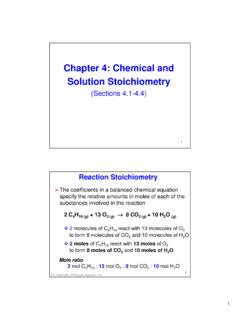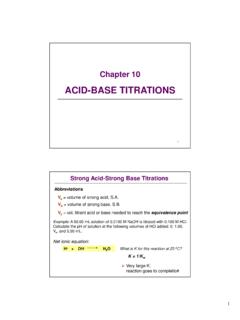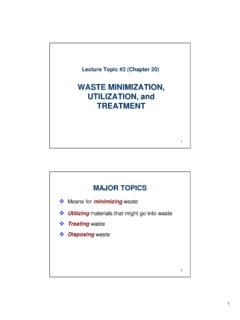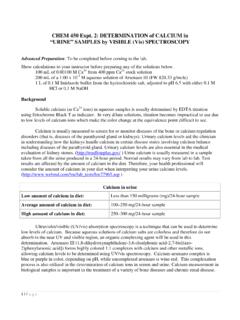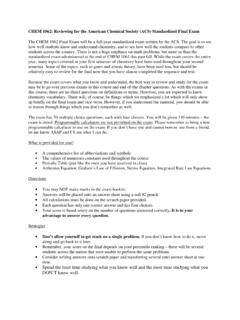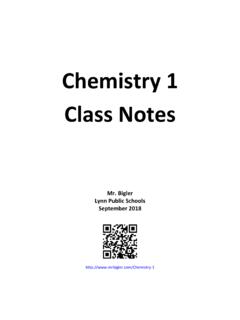Transcription of Chapter 4: Solution Stoichiometry – Cont.
1 1 Chapter 4: Solution Stoichiometry Solutions2 Molarity (dilution calculations, Solution Stoichiometry ); Solubility and Solubility Rules Molecular, Ionic and Net Ionic equations Precipitation Reactions Acid-Base ReactionsReading: Sections , , Problems: 27 a&c, 29, 31, 35c, 37a, 45b, 49, 53, 55, 57, 59, 61, 63, 67, 69, 71, 73, 75, 77, 79 and Solutions Recall from Chapter 2 Homogeneous mixtures are called solutions The component of the Solution that changes state ( saltin water) is called the solute The component that keeps its state and does the dissolving is called the solvent If both components start in the same state, the major component is the solventTro: Chemistry: A Molecular Approach, 2/e3 To describe solutions accurately, we must describe how much of each component is presentSolution Concentration Dilute solutionshave a small amount of solute compared to solvent Concentrated solutionshave a large amount of solute compared to solventTro: Chemistry: A Molecular Approach, 2/e43 Concentrations.
2 Quantitative Descriptions of Solutions A more precise method for describing a Solution is to quantify the amount of solute in a given amount of Solution Concentration= amount of solute in a given amount of Solution occasionally amount of solventTro: Chemistry: A Molecular Approach, 2/e5 Solution Concentration: Molarity Moles of solute in one liter of Solution Used because it describes how many molecules of solute are in each liter of solutionTro: Chemistry: A Molecular Approach, 2/e6amount of solute (in moles)Molarity, M = amount of Solution (in L)moles of solute M = L of solutionor simply4 Preparing 1 L of a M NaCl SolutionTro: Chemistry: A Molecular Approach, 2/e7 Example : Find the molarity of a Solution that has g KBr dissolved in L of g KBr, L solutionMolarity, MSolution:Conceptual Plan:Relationships:Given:Find:g KBrmol KBrL sol nMTro: Chemistry: A Molecular Approach, 2/e81 mol KBr = g M = moles KBr/L solutionMMKBr5 Practice 1: What is the molarity of a Solution containing g of NH3 (MM ) in mL of Solution ?
3 Tro: Chemistry: A Molecular Approach, 2/eAnswer: mol NH3 L = M NH3solution9 Tro: Chemistry: A Molecular Approach, 2/e10 Practice 2: How many grams of CaCl2 are needed to prepare mL of M CaCl2 (MM = )?Answer: g CaCl26 Dilution Often, solutions are stored as concentrated stock solutions To make solutions of lower concentrations from these stock solutions, more solvent is added The concentrations and volumes of the stock (M1, V1) and dilute solutions (M2, V2) are inversely proportionalTro: Chemistry: A Molecular Approach, 2/e11M1 V1= M2 V2 Dilution equation:Example : To what volume should you dilute 200 mL of M NaOH to make M NaOH?M1V1= M2V2orV1= 200 mL, M1= M, M2= MV2, LWORK:Conceptual Plan:Useful equation:Given:Find:V1, M1, M2V2 Tro: Chemistry: A Molecular Approach, 2/eV2=121 12M VM= V2200 mL( M) x M = 1000 mL7 Practice: What is the concentration of a Solution prepared by diluting mL of M HNO3to mL?Tro: Chemistry: A Molecular Approach, 2/eAnswer:13 Solution Stoichiometry Because molarity relates the moles of solute to the liters of Solution , it can be used to convert between amount of reactants and/or products in a chemical reaction14 Tro: Chemistry: A Molecular Approach, 2/e8 Example : What volume of M KCl is required to completely react with L of M Pb(NO3)2 in the reaction 2 KCl(aq) + Pb(NO3)2(aq) PbCl2(s) + 2 KNO3(aq)?
4 M KCl, L of M Pb(NO3)2 Volume in L of KClConceptual Plan:Relation-ships:Given:Find:L Pb(NO3)2mol KClL KClmol Pb(NO3)215 Tro: Chemistry: A Molecular Approach, 2/e1 L Pb(NO3)2= mol, 1 L KCl = mol, 1 mol Pb(NO3)2: 2 mol KClSolution:16 Tro: Chemistry: A Molecular Approach, 2/eExample : L or 350 mL of M KCl is needed for the reaction9 What Happens When a Solute Dissolves? Solute-solute attractive forces exist Solvent-solvent attractive forces also exist Mix solute with solvent What happens? If attractions between solute and solvent are strong enough, the solute will dissolveTro: Chemistry: A Molecular Approach, 2/eTable Salt Dissolving in WaterEach ion is attracted to the surrounding water molecules and pulled off and away from the crystalWhen it enters the Solution , the ion is surrounded by water molecules, insulating it from other ions The result is a Solution with free moving charged particles able to conduct electricity18 Tro: Chemistry: A Molecular Approach, 2/e10 Electrolytes and Nonelectrolytes Materials that dissolve in water to form a Solution that will conduct electricity are called electrolytes Materials that dissolve in water to form a Solution that will not conduct electricity are called nonelectrolytes19 Tro: Chemistry.
5 A Molecular Approach, 2/eMolecular View of Electrolytes and Nonelectrolytes To conduct electricity, a material must have chargedparticles that are able to flow Electrolytesolutions contain ions dissolved in water- Ex. Ionic compounds dissolved in water Nonelectrolytesolutions contain whole molecules dissolved in the water Generally, molecular compounds do not ionize when they dissolve in water the notable exceptionbeing molecular acids20 Tro: Chemistry: A Molecular Approach, 2/e11 Salt vs. Sugar Dissolved in Water21 Tro: Chemistry: A Molecular Approach, 2/eElectrolytes: Compounds that dissociate into ionswhen they dissolveNonelectrolyte: Compounds do not dissociate into ions when they dissolveDissociation of Ionic Compounds When ionic compounds dissolve in water, the anions and cations are separated from each other. This is called : Chemistry: A Molecular Approach, 2/e-Polyatomic ionsstay together as one ionMgCl2(aq) Mg+2 (aq) + 2 Cl-(aq)Dissociation of magnesium chloride:Na2SO4 (aq) 2 Na+ (aq) + SO42 (aq)12 Practice: Write the equation for the process that occurs when the following ionic compounds dissociatein (NO3)3(NH4)2CO3 CaCl2(aq) Ca2+(aq) + 2 Cl (aq)Al(NO3)3(aq) Al3+(aq) + NO3 (aq)(NH4)2CO3(aq) 2 NH4+(aq) + CO32 (aq)23 Tro: Chemistry: A Molecular Approach, 2/eSolubility of Ionic Compounds Some ionic compounds, such as NaCl, dissolve well in water at room temperature24 Tro: Chemistry: A Molecular Approach, 2/e Others, such as AgCl, dissolve hardly at all Compounds that dissolve in a solvent are said to be soluble, where as those that do not are said to be insoluble.
6 NaCl is soluble in water AgCl is insoluble in water Solubility depends on the temperature13 Practice: Determine if each of the following is soluble in (NO3)2 PbSO4 KOH is soluble because it contains K+AgBr is insoluble; most bromides are soluble, but AgBr is an exception CaCl2is soluble; most chloridesare soluble, and CaCl2is not an exception Pb(NO3)2is soluble because it contains NO3 PbSO4is insoluble; most sulfatesare soluble, but PbSO4is an exception 26 Tro: Chemistry: A Molecular Approach, 2/e14 Precipitation Reactions Precipitation reactions are reactions in which an insoluble solidforms when two solutions are mixed Reactions between aqueous solutions of ionic compounds that produce an insoluble ionic compound The insoluble product is called a precipitate27 Tro: Chemistry: A Molecular Approach, 2/e2 KI(aq)+ Pb(NO3)2(aq) PbI2 (s)+ 2 KNO3(aq)28 Tro: Chemistry: A Molecular Approach, 2/einsoluble15No Precipitate Formation = No ReactionKI (aq) + NaCl(aq) KCl(aq) + NaI(aq)all ions still present, no reaction 29 Tro: Chemistry: A Molecular Approach, 2/ePredicting the Products ofa Precipitation Reaction1.
7 Determine what ions each aqueous reactant has2. Determine formulas of possible products exchange ions (+) ion from one reactant with (-) ion from other3. Determine solubility of each product in water use the solubility rules if product is insoluble or slightly soluble, it will precipitate4. If neither product will precipitate, write no reaction after the arrow30 Tro: Chemistry: A Molecular Approach, 2/e16 Predicting the Products of a Precipitation Reaction5. If any of the possible products are insoluble, write (s)after the formula to indicate solid. Write any soluble products with (aq)after the formula to indicate soluble compounds6. Balance the equation remember to only change coefficients, not subscripts31 Tro: Chemistry: A Molecular Approach, 2/eExample : Write the equation for the precipitationreaction between an aqueous Solution of potassium carbonateand an aqueous Solution of nickel(II) chloride1. Write the formulas of the reactantsK2CO3 + NiCl2 2.
8 Determine the possible productsa) Determine the ions present(K++ CO32 ) + (Ni2++ Cl ) b) Exchange the ions(K++ CO32 ) + (Ni2++ Cl ) (K++ Cl ) + (Ni2++ CO32 )c) Write the formulas of the products - balancechargesK2CO3(aq) + NiCl2(aq) KCl + NiCO332 Tro: Chemistry: A Molecular Approach, 2/e173. Determine the solubility of each product- KCl is soluble- NiCO3is insoluble4. If bothproducts are soluble, write (no reaction)- Does not apply because NiCO3is insoluble33 Tro: Chemistry: A Molecular Approach, 2/e5. Write (aq) next to soluble compounds and (s) next to insoluble compoundsK2CO3 (aq) + NiCl2 (aq) KCl(aq) + NiCO3 (s)6. Balance the equationK2CO3 (aq) + NiCl2 (aq) 2 KCl(aq)+ NiCO3 (s)34 Practice: Predict the products and balance the equation(K++ Cl ) + (Ag++ NO3 ) (K++ NO3 ) + (Ag++ Cl )KCl(aq)+ AgNO3 (aq) KNO3+ AgClKCl(aq) + AgNO3(aq) Tro: Chemistry: A Molecular Approach, 2/einsolubleKCl(aq)+ AgNO3 (aq) KNO3 (aq)+ AgCl(s)18 Practice: Write an equation for the reaction that takes place when an aqueous Solution of ammonium sulfate is mixed with an aqueous Solution of lead (II) acetate.
9 (NH4++ SO42 ) + (Pb2++ C2H3O2 ) (NH4++ C2H3O2 ) + (Pb2++ SO42 )(NH4)2SO4 (aq) + Pb(C2H3O2)2 (aq) (NH4)2SO4 (aq) + Pb(C2H3O2)2 (aq) NH4C2H3O2+ PbSO435 Tro: Chemistry: A Molecular Approach, 2/eInsoluble(NH4)2SO4 (aq) + Pb(C2H3O2)2 (aq) NH4C2H3O2(aq)+ PbSO4(s)(NH4)2SO4 (aq) + Pb(C2H3O2)2 (aq) 2NH4C2H3O2(aq)+ PbSO4(s)Finally, balance the equation: Molecular equations 36 Reference: written to represent precipitation reactions can be written in one of three ways: Ionic equations - All soluble reactants and products are written as ions- Only the precipitate is written as if it were a molecule Net Ionic equations - Only the reactants and product taking part in the reaction are written in the equation --- reactants as ions; product as ionsare not included in the equation - All reactants and products are written as if they are molecules19 Molecular equations Inmolecular equations , all reactants and products are written as ifthey are molecules37- Species in Solution must include the soluble compounds (aq) and the precipitate (s) Example:NaCl(aq) + AgNO3 (aq) -----> NaNO3 (aq)+ AgCl(s) equations In ionic equations , all species in Solution are written as ions; the precipitate is written as if it were a molecule.
10 38 Example:Na+ (aq) + Cl-(aq) + Ag+ (aq)+ NO3-(aq) ----> Na+ (aq) + NO3-(aq) + AgCl(s) Ionic equations Net ionic equationsare written like ionic equations except that spectator ionsare not included in the equation: 39 Example:Ionic: Na+ (aq) + Cl-(aq) + Ag+ (aq) + NO3-(aq) ----> Na+ (aq) + NO3-(aq) + AgCl(s)Net ionic: Ag+(aq) + Cl-(aq) ------> AgCl(s) chlorideIonic equations Cont. Ions that are both reactants and products are called spectator ions (Ex. Na+and NO3-ions below)Na+(aq) + Cl (aq)+ Ag+(aq)+ NO3 (aq) Na+(aq)+ NO3 (aq)+ AgCl(s) An ionic equation in which the spectator ions are removed is called a net ionic equationExample: Cl (aq)+ Ag+(aq) AgCl(s)40 Tro: Chemistry: A Molecular Approach, 2/einsoluble Remember to name and write the metal cationfirst in an ionic compound21 Practice: Write the ionicand net ionicequation for each of the reactions : 2K+ (aq) + SO42 (aq) + 2Ag+ (aq) + 2NO3 (aq) 2K+ (aq) + 2NO3 (aq) + Ag2SO4 (s)K2SO4(aq) + 2 AgNO3 (aq) 2 KNO3 (aq) + Ag2SO4 (s)Na2CO3 (aq) + 2 HCl(aq) 2 NaCl(aq) + CO2 (g)+ H2O (l)41 Tro: Chemistry: A Molecular Approach, 2/eNet ionic: 2 Ag+(aq) + SO42 (aq) Ag2SO4(s)Ionic: 2Na+ (aq) + CO32 (aq) + 2H+ (aq) + 2Cl (aq) 2Na+ (aq) + 2Cl (aq) + CO2 (g)+ H2O (l)Net ionic.
